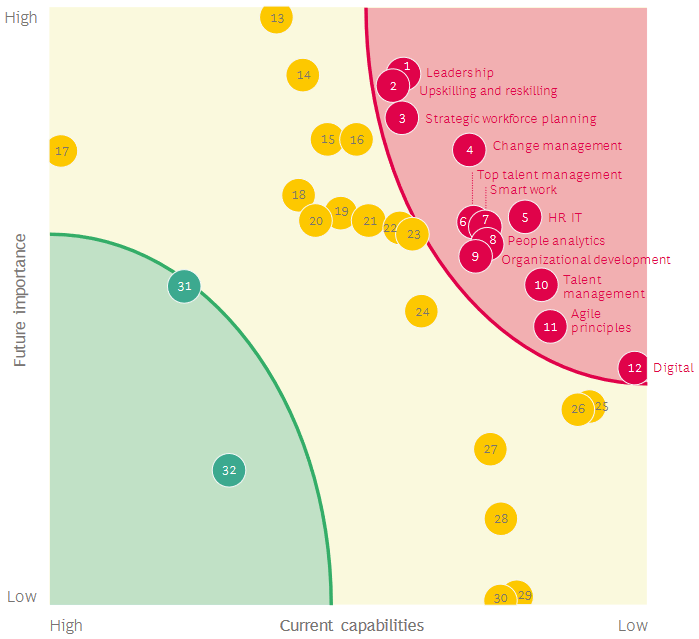The COVID-19 pandemic has changed a lot. I hardly know any area or industry that has remained unaffected. For some the development was very positive, for others it was life threatening. How was the development of workforce analytics (WFA) / people analytics?
How do you feel about it? In my opinion, the development is divided into two parts:
- As before, many companies of different industries and sizes have not yet recognized the potential of WFA. They are satisfied with “classic” HR controlling (look in the rear-view mirror), are at best neutral towards WFA and rate the topic as subordinate – also because of the pandemic.
- An increasing number of companies are not only using WFA; they are constantly expanding their competence in this area. This is confirmed by the recently finalized survey by Insight222. According to this, 75 percent of the companies surveyed worldwide stated that their WFA function will grow in the next 18-24 months – by the end of 2023. The pandemic has really pushed this issue; This especially with a view to the accuracy for daily operational decisions and the long-term strategic scenario planning.
According to a BCG publication “Creating People Advantage 2021” from June 2021 – 6,600 participants in 113 countries – there is an urgent need for action in the area of WFA; here is an excerpt:
On a 9-point scale, companies in Germany rate their current skills with “8” (hardly any skills), Swiss companies with “5” (mediocre skills). In addition, companies in Germany and Switzerland give a “2” (very high importance) with regard to future importance.
Where do you currently see your company on a 9-point scale in terms of skills and importance? What is your target image when it comes to WFA?
In a small series of articles – you are currently reading Part 1 – I will deal with the essential content that I believe belongs to such a target image. As is so often the case, a lot depends on the basics. That is why I will deal with one dimension of the “Nine Dimensions for Excellence in People Analytics“: Governance.
Six types of governance
Ferrar and Green distinguish the following six types:
- Ethics and data protection in relation to personal data and analysis,
- the financial model for determining the ROI of analytics projects,
- the administration of personal data,
- the prioritization of projects and tasks for analytics,
- the operating model for the success of the WFA team, as well as
- a board that holistically supports the strategy and work of the WFA team.
In the following I will go into detail on ethics and data protection. Because the biggest risk for today’s WFA teams is not the technology, the lack of available skills (to perform analysis) or the existing budget, but the misuse of employee data. And that risk is growing exponentially due to the new way we collect and use employee data.
Six steps to ethically sound WFA
In addition to an ethics charter, companies need a governance process for personal data so that the charter can be activated. A governance process balances the opportunities and risks of WFA. A few months ago, Insight222 summarized its experience in six recommendations:
- Define what is important: The principles of the approach to collecting, analyzing and sharing personal data must be clearly defined.
- Align the views of the key actors: As soon as the most important stakeholders are known, the most important concerns of each should be addressed. As long as there is no agreement here, the principles and principles should be adapted.
- Showing and communicating the specific individual benefits: The strength of the Ethics Charter is that it enables companies to advance analysis projects faster. However, this only works if the charter is known and accepted. A proactive and sustainable approach to communication is key to socializing the charter internally.
- Create the governance process: The charter creation is not a one-time conversation, a day-long meeting, or an off-site. A really effective charter creation is also a change management process.
- Develop the implementation plan: This plan borders on the multi-stage creation process. It must contain clear action steps for each phase of the EFA project.
- Translate the ethics charter into questions of action: A charter and decision-making model can be implemented if it can be tested. Specific questions, e.g. based on Dirk Petersen, should be used to test whether the project complies with agreed ethical standards:
- Is the planned project legal? Is it in line with the Ethics Charter?ho will receive the result of this analysis? Do we like to share this with employees? Do we need express consent to use the data?
- Is there a clear methodology for performing the analysis? Is it easy to explain? How long do these data / analyzes have to be kept?
Conclusion
Governance refers to the mechanisms, processes and procedures by which WFA works. It therefore underpins all analyzes and ensures that the right people are setting the direction, that the structure and responsibility for the management of data and projects are implemented and applicable, and that risks are appropriately managed.
According to Ferrar and Green, six stakeholders in particular should be involved: law / data protection, IT, employee representation, HR, executives and internal communication.
Representatives of these areas form the so-called People Data Governance Council. Its role is to review all new major projects or technologies, weigh opportunities and risks, and make strategic decisions. It is therefore important to appoint representatives to this council who are senior enough to be respected and classified as trustworthy by the organization.



Leave A Comment